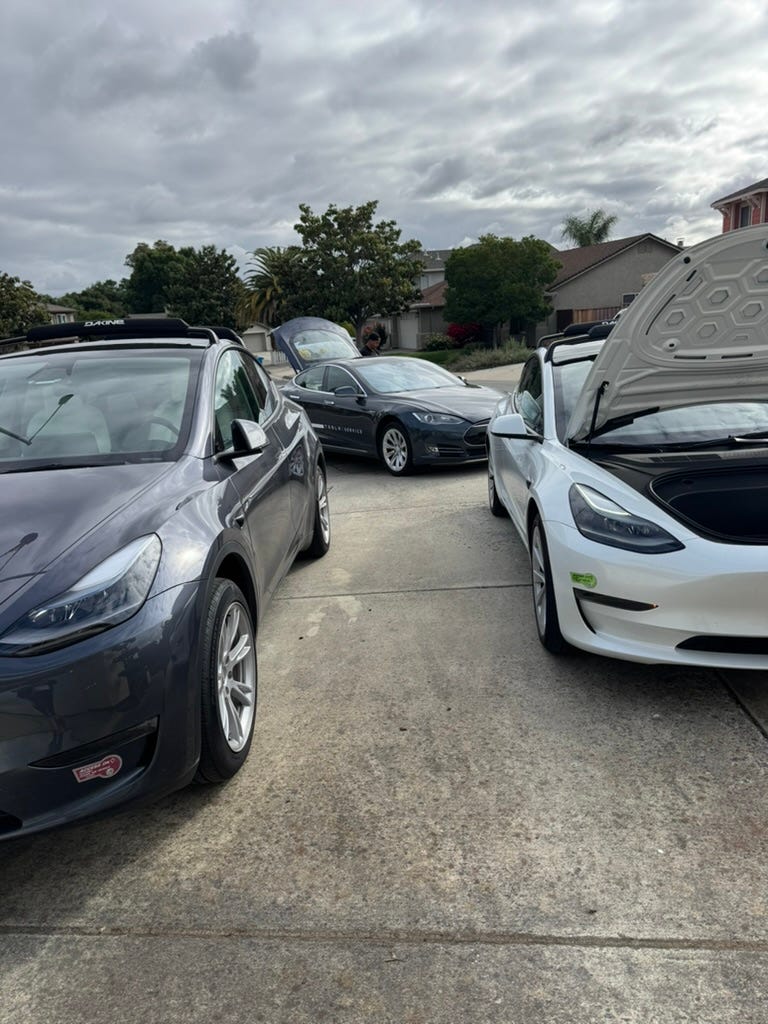It’s a crisp Tuesday morning, and the Tesla mobile service technician shows up at 8:32 AM—just two minutes into his time window. He’s smiling, friendly, and remembers both my husband and me from a previous visit.
In that moment, I’m reminded why we’ve kept our Teslas. Service that comes to you, without upsells or stress. It’s seamless, personal, and quietly revolutionary.

And then—like a software update that erases your favorite feature—I remember who runs the company. The moment feels surreal: a service so flawless and human-centered, contrasted with leadership that often feels erratic and out of touch.
The Service Is Still Revolutionary
Tesla’s mobile service is one of the company’s most underrated innovations. According to Tesla’s 2023 Impact Report, over 30% of its North American service visits now happen remotely. I’d heard about this “perk” before we purchased our first Tesla, but never looked into it. If I had, I probably would have purchased an EV years earlier for this one benefit alone. Beyond the extraordinary luxury of car service in your driveway, EVs require less service. (Unless you own a Cybertruck and you’ve had been tortured through eight recalls in six months. But, we won’t go there.)
EV Maintenance: Fewer Parts, Fewer Problems
Electric vehicles have a mechanical simplicity that dramatically reduces service needs. Most EV drivetrains contain just 20–25 moving parts, compared to 200–2,000 in an internal combustion engine. That translates into fewer failure points, no oil changes, and simplified transmissions. Regenerative braking also reduces wear on brake pads, extending the lifespan of the braking system. And without tailpipes, mufflers, catalytic converters, or oxygen sensors, there’s no exhaust system to service or replace.
The U.S. Department of Energy confirms that EVs “typically require less maintenance than conventional vehicles,” while multiple industry analyses estimate a 40% to 49% reduction in service costs compared to gas-powered cars. Ford, for example, reports that scheduled maintenance for its F-150 Lightning is 49% cheaper than for the combustion-powered F-150 over five years or 75,000 miles.
(Full disclosure: I have serious concerns about the public safety impact of turning massive pickups into even heavier battery-electric vehicles. While some call the F-150 Lightning a “marvel of engineering,” I nervously see it as a 6,000-pound battering ram in traffic. That said—Ford isn’t wrong about the maintenance savings.)
While EVs still require tire rotations, cabin air filter changes, and the occasional software or coolant update, the overall cost of ownership remains significantly lower—often offsetting the higher sticker price within a few years.
These design advantages eliminate entire service categories—spark plugs, mufflers, timing belts—and cut down on shop visits. Paired with Tesla’s remote diagnostics and over-the-air software updates, EV ownership becomes not just cheaper, but far more convenient.
How much does it cost for all this driveway convenience? Our last service cost $65 per car. We’ve spent more than that on vegan burgers and drinks. On a scale of one to fun, watching the Tesla service tech work out our [home] office windows never gets old.
People Are Ditching Their Teslas Like The Titanic Headed For an Iceberg
Yes, some celebrities have jumped ship:
Bette Midler: Called her Tesla “a symbol of racism, greed and ignorance.” (Perhaps I should have used the analogy “the Hinderberg coming in for an ill-fated docking maneuver.”)
Sheryl Crow: Sold hers and donated the money to NPR.
Jason Bateman and Senator Mark Kelly also distanced themselves over Musk’s politics.
(Sources)
From Road King to Roadkill: Tesla’s Historic Sales Collapse
The impact on Tesla sales in 2025 hasn’t just been sharp—it’s been historic. Global vehicle deliveries fell 13% year-over-year in Q1, down from 495,570 in Q4 2024 to just 336,681. That’s a staggering 32% quarter-over-quarter drop—the steepest in the company’s history.
The Wheels Came Off: Tesla Sales Tank Globally
Europe’s numbers are even more dire. Sales are down nearly 40% year-to-date and collapsed 46% in April alone. Model Y sales dropped 51% that month. Country by country: the UK is down 62%, Denmark 67%, Netherlands 74%, Sweden 81%, France 59%, and Portugal 33%. In Quebec, Tesla sales plummeted 90% in Q1.
Too Fast, Too Furious, Too Elon: The Tesla Retraction Begins
This isn’t a macro EV problem—EV sales are up 11% in the U.S. during the same period. Tesla’s downturn is driven by backlash against Elon Musk’s politics, growing competition from Chinese automakers like BYD (which now outsells Tesla in Europe), and a stagnating product line. Analysts project a further 5–9% global decline by year’s end. Tesla’s Q1 net income fell 71%.
But Owners Aren’t Letting Go
Despite a significant reputational hit and increased trade-ins amid the Elon Musk backlash, Tesla owners display the highest loyalty and retention rates in the automotive industry. The data shows that while some owners leave, the vast majority are sticking with their Teslas, and most say they would buy another. Tesla’s product experience, charging network, and EV leadership continue to outweigh the CEO’s controversies for most owners. Despite increased competition and negative headlines, Tesla’s owner loyalty and retention remain industry-leading in 2025, and the brand continues to outperform all rivals on this metric.
And I see it too: On my morning walk, it’s not uncommon to see multiple Teslas in a row drive past. On the freeway, I still end up in convoys of Teslas. (Somehow, the cars seem to prefer traveling in packs. Go figure.) And, when I park my car, I come out and it’s made a friend. There is often another Tesla parked next to it.
The Teslas I see are primarily the “classic” ones. Not the new Cybertruck aesthetic ones. The ones that whisper, “I bought in when this felt like the future.”
But for me? I won’t buy another. Not as long as the company is led by someone whose values I find irreconcilable. Trust matters—and I wouldn’t trust this CEO to make me a cup of coffee, let alone guide company policy. (OMG- just picturing that man trying to make coffee. LOL.)
If they fire his racist butt? Yeah, I’d consider getting another one.

The Ethical Reckoning
My internal conflict isn’t about hardware. It’s about humanity.
In 2025, Bill Gates publicly accused Elon Musk of “killing the world’s poorest children”—not figuratively, but directly—through his role in overseeing catastrophic cuts to the U.S. Agency for International Development (USAID) under the Trump administration. As head of the so-called Department of Government Efficiency (DOGE), Musk advocated slashing global aid by nearly 80%. These weren’t abstract budget lines—they were maternal care clinics, HIV prevention programs, and child nutrition efforts in some of the most fragile parts of the world.
Gates cited the abrupt termination of grants to hospitals in Mozambique that were preventing mother-to-child HIV transmission, calling it one of the worst reversals of public health progress in decades. UNICEF, the WHO, and other agencies echoed the alarm: millions of women and children are now cut off from lifesaving care. A KFF analysis found that 86% of USAID’s maternal and child health awards were terminated. UNICEF projects 14 million children will face nutrition disruptions this year alone, with modeling studies predicting hundreds of thousands of preventable deaths.
Elon Musk’s response? He compared the cuts to “feeding USAID into the wood chipper.”
Inside the Tesla: logic, clarity, renewable energy.
Outside: a figurehead destabilizing public health, mocking humanitarian norms, and tweeting conspiracy theories like it’s performance art.
The contrast could not be more jarring.
Reclaiming the Machine
This machine was never his.
It was built by engineers, designers, and quiet geniuses with socket wrenches and source code.
It was shaped by vision, not vanity.
Because I’m not mad at the car.
I’m mad at what it’s been forced to represent.
Tesla can be more than one man’s echo chamber.
It always was. It meant something to the people who drove it. Still does.
We—what they once called Tesla Nation—were always more than Elon Musk.
And we’ll still be here long after he’s replaced by someone who understands the base.
Someone who leads with intelligence, not impulse.
Someone who knows that trust, once lost, doesn’t reboot with a software update.
Check out the video I did when we first bought the car. Things felt different back in mid- October 2022.
My favorite snarky comment on the video:
Other articles on Tesla by Deep Learning:
Spotify: Deep Learning with the Wolf. Tesla's Troubled Times (February 14, 2025.)
What is Tesla’s end-to-end neural network? (April 1, 2024.) LinkedIn.[First-hand accounts]
FSD Beta 12 and Tesla's "Meet the Engineers" Event. (March 31, 2024. LinkedIn. Does Buying the SLATE mean we've given up on TESLA?(April 25, 2025.) LinkedIn.
#Tesla #EV #ElonMusk #TechEthics #ElectricVehicles #FSD #AIAccountability #EngineeringMatters #EVMarket #ReclaimTheMachine #DeepLearningwiththeWolf #theDroidsNewsletter #TeslaModel3 #TeslaNation #TeslaAutoPilot #TeslaFSD


















Share this post